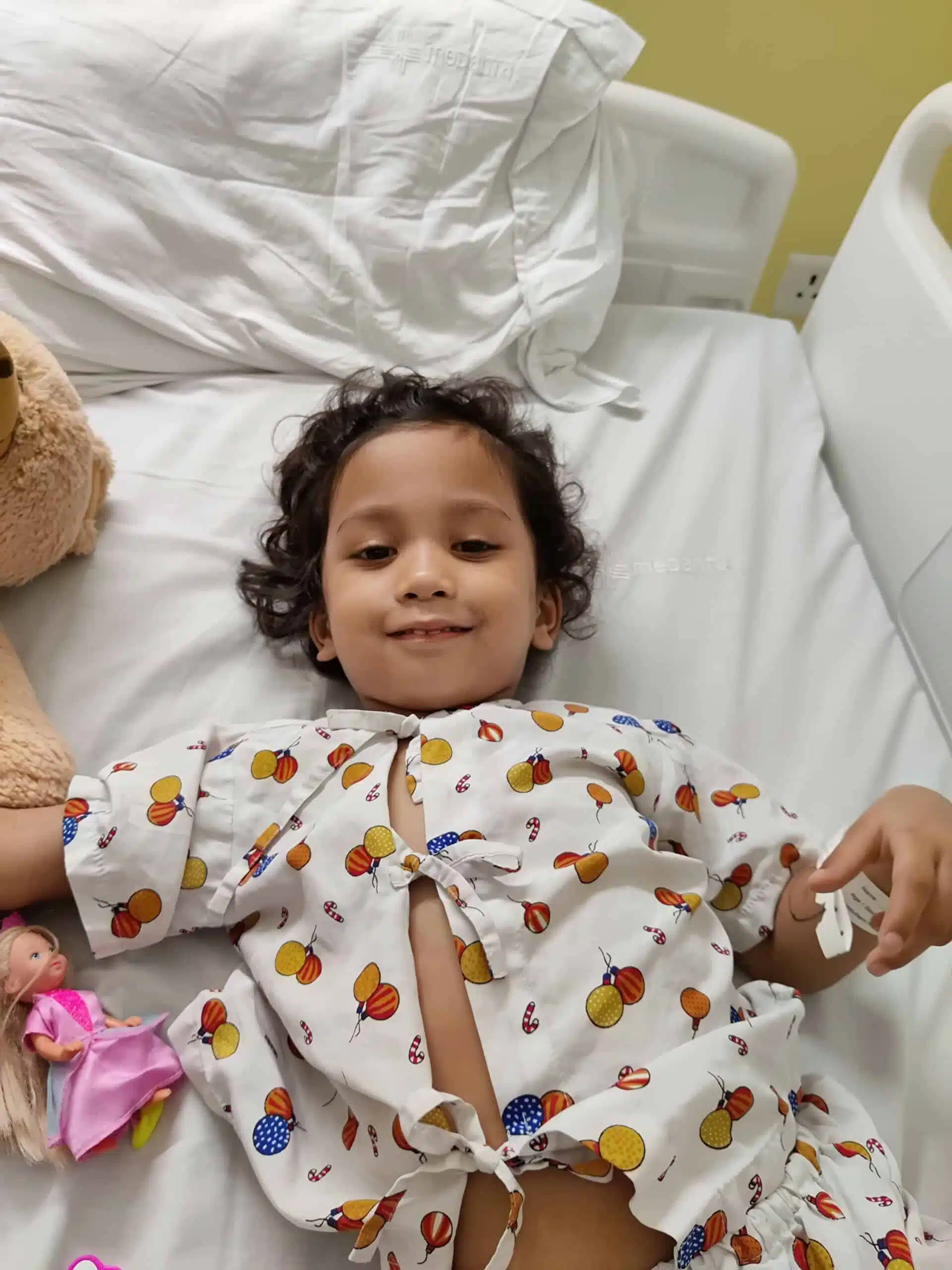It all started with a harmless fever early this month. In my growing-up years, fever was considered a good sign. I remember my grandmother saying, ‘a fever means your body is fighting.’ Though I also remember her always adding a firm admonition, ‘but, don’t ever let it rise too much.’
As a parent, I am not the one who cares too much about a passing cold or flu. I rarely even take the kids to a doctor. Home remedies, a dose of paracetamol, and they are good to go.
So I tried to deal with the illness that visited us early last month exactly in my style. Little did I know, I was wrong and this was a test I wasn’t quite prepared to take.
My two-months-short-of-four-year-old is a spirited little girl. When I noticed that, unlike her usual self, she was a little dull, I decided to go against my usual nonchalant style of dealing with an illness. I took her to the doctor.
Of course, medicines were prescribed.
That’s when began the first challenge of the test.
The ordeal of giving medicine to a strong-willed child.
While I was recounting the ordeal we went through recently, a dear friend shared a quote by the comedian Papa CJ: Tragedy + Time = Comedy
As I write this, I am smiling. However, back then, there seemed nothing comical about it ladies and gents! Oh no, it didn’t!
We tried everything! And failed miserably. Again and again.
Here are the many approaches we adopted:
Gentle cajoling
This involved:
- A short lecture on the benefits of medication
- Tales from our childhood about how wonderful we were when it came to swallowing bitter medicines
- Adding sugar to the syrup and even mixing it in juice
- Playing Julie Andrews and singing the classic, ‘A spoonful of sugar makes the medicine go down..’
However, the medicine only went down the plughole. The two-months-short-of-four-year-old obstinately refused to open her mouth.
That’s when someone suggested, approach #2. I wasn’t much in favor but was willing to give it a try.
Bribing
This involved:
- Offering candy to the child in question. However, this offer was outrightly rejected.
- Screen time: Now for a child usually deprived of the idiot box, this technique seemed to work. After a lot of negotiation, we agreed that she take the medicine while the show on TV was on. Distraction would keep the bitter taste at bay.
- We switched on the television, set it to the liking of the child in question, and waited for her to keep her side of the bargain.
We failed miserably and the child got screen time on a non-screen-time day.
That’s when, much to my opposition, the other half lost patience (I know, too early in the test. But, don’t you judge us! And, we moved to approach #3)
Pinning down
This involved:
- Three grown humans pinning down a two-foot-something fledgling
- A fourth-grown human opening the mouth
- A fifth-grown human, usually the mother, depositing the dose into the mouth
However, this led to a projectile vomit attack on all five grown humans involved and the hands of the fourth grown human were deeply etched with milk teeth impressions (Do not take milk teeth lightly!)
When we failed this too, we began to threaten her. I vividly remember some of my own words. ‘We will have to take you to the hospital. That’s where the doctors and nurses will do this their way. They will give you injections.’
(Funny isn’t it? You say stuff you don’t really mean and it comes true. Some wise person had once said, ‘choose your words wisely and carefully.’)
However, no amount of threats seemed to work. At last, I gave up.
Her body fought well and the fever was defeated. It felt like a little victory and life went back to normal. But, only for a week. The fever was back again.
This time around we managed to administer at least the fever medicine. She still wouldn’t accept the antibiotics. Somehow, we managed to break the fever, again.
However, after another week my older one fell sick. High fever, cough, body aches! It seemed like a nightmare. The only consolation was that, at 10, he accepted the medication painlessly and recovered within three days.
I was beginning to feel better already. I am a positive person and thought this was all behind us now. Unfortunately, I was wrong.
This test that had come knocking at our door wasn’t an easy one. We were harshly thrown to the next level.
The fever was back and this time our little one was hit again. She possibly caught it from her brother since her immunity was already compromised, thanks to her several not fully resolved fever episodes.
This time I was scared.
The doctor advised a blood test after three days of fever. There were sleepless nights of fever shooting up, sponging for hours on end, and sometimes a double or even triple dose of the fever medicine.
Finally, when the blood test happened, the report scared the hell out of me! The infection levels were insane. Even to my eyes, the eyes of a layperson, I knew the numbers were absolutely haywire.
The doctor gave me a choice. Either get a cannula fixed and administer the antibiotics at home or hospitalize her.
I hate hospitals. I am sure no one likes them but when I choose the word ‘hate’, I mean, I cannot stand the sight of hospitals. I fear them. I avoid them. I detest them. Obviously, the former option seemed like a good one to go with.

My 6 Integral Lessons on Problem-Solving and Decision Making
1. If you are thrown into deep waters, and even if you don’t know how to swim, you flail about because you want to survive!
2. In trying times you make unlikely choices and you do that at the drop of a hat.
3. Insurmountable difficulties make you fierce. Fiercer than you can ever imagine!
4. Even if you think you are alone, you really aren’t. A support system stands behind you like a firm wall. And when you stagger and fall backward, they catch you. They stay there for you to lean on. They embrace you, they comfort you, they feed you, even when you oppose. And, sometimes they just let you be.
5. The power of prayer is unmatched
And, here’s my biggest takeaway:
6. A mother’s gut instinct is always right!
I decided to go with hospitalization.
Needless to say, the next few days were the most difficult part of the test. But, by now I was no longer running away from the test. I was in it, it was inescapable. I had to make it through.
It’s not easy to see your baby in pain. Yes, but I didn’t shed a single tear. Each time the cannula was inserted, I held her tightly, sometimes whispering and sometimes screaming, but always, words of comfort.
I also chose to be completely honest with her. Each time the needles appeared, she would ask me, ‘will it hurt, mamma?’ and I would always say, ‘yes!’
Each time we were wheeled for a test, I would prepare her. Tell her what to expect there. Trust was a very important factor between the both of us, especially during this time. In a crowd of strangers, she was always petrified of – I didn’t want to desert her. The doctors and nurses would lie easily, ‘nothing will happen. Don’t worry. We are doing nothing to you,’ they would always say. I had to remain true to her. I had to tell her what was coming. And, guess what, through this ordeal, she didn’t lose the only friend she had in a hospital full of strangers.
Each time she cried in pain when the medicines stung her tiny hands as they rushed into her veins, I comforted her with stories, songs, and sometimes a silent prayer.
I pushed away all my fears. And waited.
I stayed positive. And Prayed.
When she cried herself to sleep in my arms, I whispered in her ear, ‘You are fine. You are getting better. We will go home soon.’
My daughter is a fighter, she is resilient but after a week of hospitalization, I noticed that her spirits were low. She wasn’t fighting, she wasn’t resisting. She was accepting. Now, that may seem great, for you know, it’s not easy to poke needles into flailing and fighting a child.
But, no, I had to see the fighter back. So I donned the hat of an entertainer. I played a storyteller, a joker, and a singer. It worked, yes. But, why was this happening? I reflected, were my spirits low too? Was I losing hope too?
Hope is like the grip of a parent’s hand, it stays strong for as long as you don’t let go. Or so you feel.
What will happen if you do let go of the grip? You fear that your child may go astray. May get lost. May get hurt.
However, if you don’t let go, how will the child grow?
My relationship with hope was also becoming complicated. I was holding on too tightly. It was hope laced with fear.
One night, I think it was the tenth night of hospitalization, as she slept in my arms and I tried to synchronize my breath with hers, I had an epiphany. I carefully placed her on her own and lay down next to her. I let go of whatever I was holding on to so tightly.
I took a deep breath and slept. The beeps of the machines that usually kicked my anxiety and kept me up all night lulled me to sleep. We both slept through the night.
Things started getting better after that. We got discharged after two weeks of hospitalization. She’s still recovering and I am sure will bounce back quickly.
Did I pass the test? I don’t know. At one point, deep into the test, I forgot all about the test. I brushed aside my fears and attempted to offer oral medication.
Guess what? She’s accepting the medicines painlessly. Yes! Now, you may call it experiential learning or learning it the hard way, I don’t know.
What I feel is, I am not anxious anymore.
Here’s something I learned about Support System
1. One needn’t be around you to give you strength. My ten-year-old may not have visited the hospital, he may not have had detailed telephonic conversations, and he kept his voice impassive each time we spoke, but he supported us by looking after himself.
2. I was approached by a few healing groups who prayed for us – day and night and all their prayers gave us strength.
3. Family and friends like family stood by us. Their presence gave us strength.
4. We both gave each other strength. She may have been the unwell one but for a lot of days and nights at the hospital, I felt I was plummeting. Her strength to fight back gave me strength.
And, before I go I must share. Just this afternoon, we had a comical episode of me running behind her all over the house because somebody had come home to collect a follow-up blood sample. And yes, it took five grown humans to pin her down.
P.S. Did I mention it? She even bit a nurse at the hospital. Well, that’s a story for another time.
Must-Read Blogs:


Each story,chapter,episode,day,event of our lives,comes with an embedded lesson,we learn as we live… and YES,a mother’s gut feel is ALWAYS correct!,
keep writing,keep sharing
Sending hugs
May she stays strong and safe! The story gave me tears and made me recollect the upsetting stories of hospital. More power to you Rohini 🙂
This made me tear up.. lots of squishy hugs to you and M. See you soon.